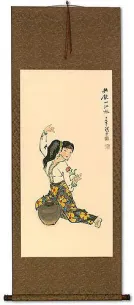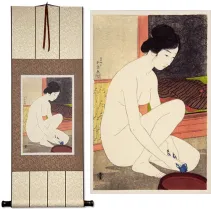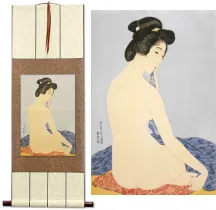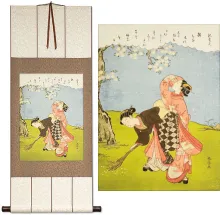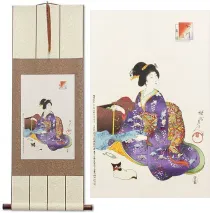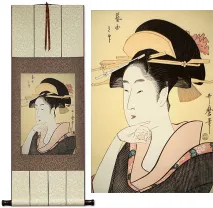Bathing In Cold Water
Japanese Nude Woman Print Repro Scroll


46¾"
18¼"
• Delivered to you in Columbus by Dec 19th.
• Standard shipping is just $3.80 for any order.
• Limited Edition Print - I might make more.
• Fine Art Giclée Print.
• Handmade Wall Scroll.
• Money-Back Guarantee.

This Asian woman artwork will look great in your home or office.
Approximate Measurements
Artwork Panel: 28.2cm x 58.1cm ≈ 11" x 22¾"
Silk/Brocade: 37.3cm x 118.9cm ≈ 14¾" x 46¾"
Width at Wooden Knobs: 46.3cm ≈ 18¼"
Information about caring for your wall scrollSee Larger Image









Bathing In Cold Water
Cold Spring Bath

Close up view of the Asian woman artwork mounted to this silk brocade wall scroll
This depicts the back of a nude woman as she steps into a bathtub. Images of nude beauty like this are rare in Ukiyo-e. Here, the softness of women's skin and the graceful depiction of the neckline portray the ideal beauty of Japanese women unique to the artist Utamaro.
It is believed that this may be Shogi (Shogi in Japanese or Zhaoyi in Chinese), a lady-in-waiting officer of the Western Han, who is soaking in the Lantang (Lantang = orchid bath). The original image was probably made around 1799 (11th year of Kansei) judging from the subject matter and known history of the artwork.
The commonly-known title of this image is 寒泉浴図 ("Bathing In Cold Water", "Kansen Bath Image", or "Cold Spring Bath"), though on this version it's written 蘭湯灔々昭儀坐其中 meaning "Shogi of Han sits in the Lantang".
At the lower left, you will find a signature with the pen name 歌麿筆 (Utamaro Hitsu). The artist's full name is 喜多川歌麿 (Kitagawa Utamaro). He was born in Japan in Edo (now known as Tokyo) around 1753. He only lived to the age of 53, dying in 1806.
Utamaro is one of the most highly regarded designers of ukiyo-e woodblock prints and paintings being most prolific in the 1770s thru 1790s. He was one of very few ukiyo-e artists to gain exceptional fame during his own lifetime.
There are additional characters on this artwork after the title 蘭湯灔々昭儀 坐其中...
...若三尺寒泉
浸明玉
録飛燕別集語 鴬谷吏垣
But I have not yet translated this fully. It's in kind of classical Japanese with influence from Chinese grammar of that era (hard to translate).
Original artist: Kitagawa Utamaro / 喜多川歌麿 (1753-1806).
Publisher: Kaneko Fusui or Shin'eidô
Original woodblock was created in Japan, in 1799.
About Real Japanese Woodblock Prints
Woodblock printing, often considered the precursor to the modern printing press, was first developed in China and later brought to Japan, where artists refined the technique into a unique art form. In Japan, these prints are called 木版畫 ("Moku Hanga"). Most were created during the Edo period (1603–1867), though production continued into the early 20th century.
Japanese artists would first create a "template painting" depicting scenes of daily life, including women washing clothes, men writing poetry, samurai battles, and occasionally more dramatic subjects. These template images, known as 浮世絵 (Ukiyo-e, or "Floating World"), were then carved into wood by skilled artisans. Another specialist applied wet ink or pigments to the carved blocks, and a sheet of handmade paper was pressed on to create the final print. This collaborative process produced vibrant, detailed artworks much faster than hand-painting hundreds of copies.
About This Reproduction
Original Japanese woodblock prints from the Edo period can sell for $800 to $20,000. Our prints are high-quality reproductions, crafted to capture the look and feel of the originals, though experts will recognize them as reproductions.
We use authentic handmade kozo (mulberry) paper—the same paper Japanese printmakers used centuries ago. Archival, UV-resistant pigment inks ensure long-lasting color, with laboratory testing showing up to 95 years of fade-free enjoyment if kept out of direct sunlight. Each reproduction is carefully color-corrected and restored, bringing the Edo period artwork to life for your wall.
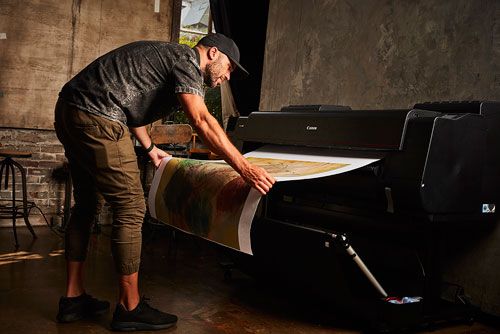
Photographer Jeremy Cowart and the Canon imagePROGRAF PRO-2000 giclée printer used to create these reproductions.
Printing on delicate handmade paper is challenging. After testing multiple high-end printers, we found the Canon imagePROGRAF PRO-2000 delivers the precision and quality needed, using 12 archival inks and 18,432 nozzles. Each print is then sent to our Beijing workshop, where it is mounted into a handmade wall scroll, ready-to-hang without the need for expensive framing, giving your piece an authentic Japanese look.
Because the original artist has long passed, these works are public domain. In some cases, we license high-resolution scans of original prints, or even scan 200-year-old originals ourselves. This dedication ensures you receive a stunning Japanese woodblock print reproduction at an affordable price, making traditional Asian art accessible to everyone.
Want a custom wall scroll or unique print size? Just contact us!
We can print larger sizes, choose your preferred paper texture, and select silk brocade colors. Ready-to-frame prints can ship in days, while custom wall scrolls may take several weeks. Either way, the result is a truly one-of-a-kind piece of Japanese art.
This item was listed or modified
Jul 8th, 2025



